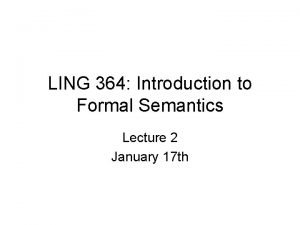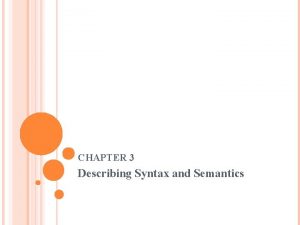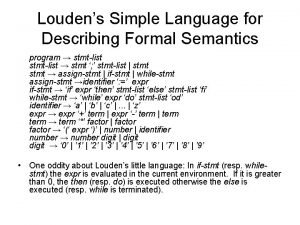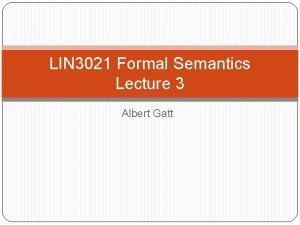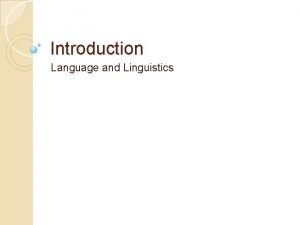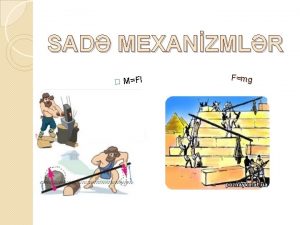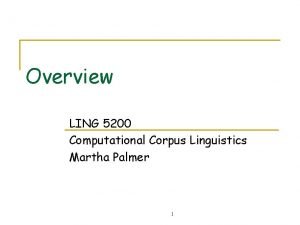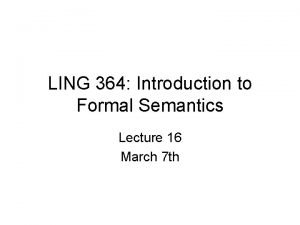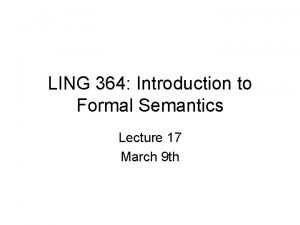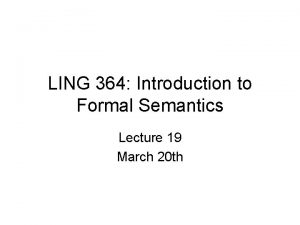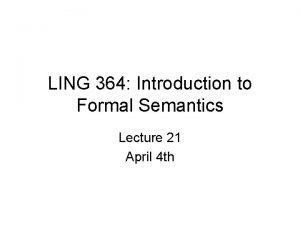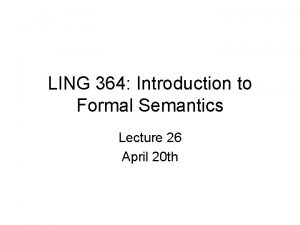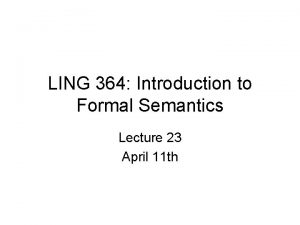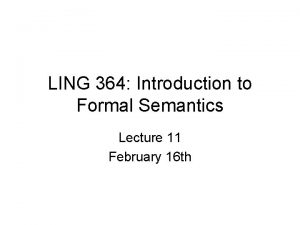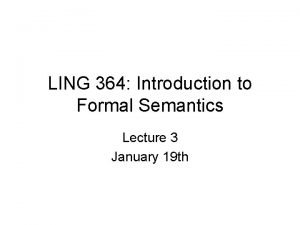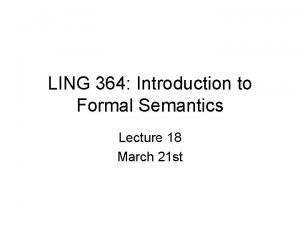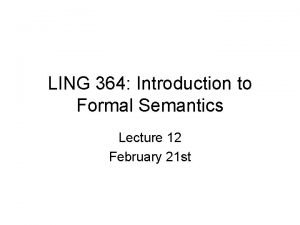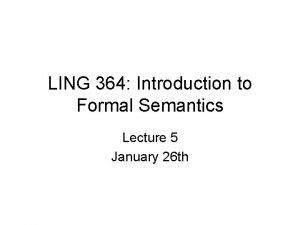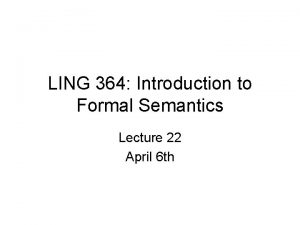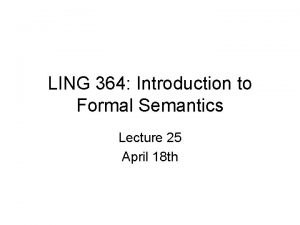LING 364 Introduction to Formal Semantics Lecture 19















- Slides: 15

LING 364: Introduction to Formal Semantics Lecture 19 March 28 th

Administrivia • Homework 4 due today – usual rules: in my inbox by midnight – handed out last Tuesday

Today’s Topic • Finish Chapter 5

Last Time • (Section 5. 3) • Contrast Novelty (indefinite) and Familarity (definite) • Example: – (6 a) A dog (new information) came into the house – (6 b) The dog (old information) wanted some water • (Section 5. 4. 1) Names = concealed descriptions • Example: – (A) (Name) Confucius – (B) (Definite Description) the most famous Chinese philosopher – both seem to “pick out” or refer to a single individual but there is one important difference: – (B) gives you the criterion for computing or picking out the individual

Last Time • (Section 5. 4. 2– 3) • • Names are directly referential Variations: – Kripke: names are non-descriptive, names refer to things from historical reasons (causal chain) – Evans: social context is important (names can change wrt. referent) • Examples: – Madagascar • • originally named part of mainland Africa as a result of Marco Polo’s mistake: the island off the coast of Africa – – – kangaroo “I don’t understand” (aboriginal) ganjurru (Guugu Yimidhirr word) ono (a fish: aka wahoo) “good to eat” (Hawaiian) – – livid as in “livid with rage” pale or red

Last Time • • • (Section 5. 4. 4) Referential and Attributive Meanings Russell: definite noun phrases do not refer at all Example: – the teacher is nice teacher 99 (directly referential) – there is exactly one X such that teacher(X), nice(X). – (attributive: no direct naming) Donnellan: both are used – Jones has been charged with Smith’s murder – Jones is behaving oddly at the trial – Statement: “Smith’s murderer is insane” (referential) – everyone loves Smith – Smith was brutually murdered – Statement: “Smith’s murderer is insane” (attributive)

Last Time • • (Section 5. 5) (Topic of Homework 4) Plural and Mass Terms Godehard Link: Lattice structure Example: possible worlds (w 1, . . , w 4) – a mapping from world to a set of individuals • • w 1 → {A, B} w 2 → {B, C} w 3 → {A, B, C} w 4 → ∅ horse(a). horse(b). horse(c).

Last Time • W 3: – meaning of horse: {A, B, C} – meaning of horses: {A+B, A+C, B+C, A+B+C} • Lattice structure representation: three horses A+B+C horses(X). A+B B+C A B C chinese: ma (马) ma(X). horse(X).

Last Time • • Mass nouns: “uncountable” Examples: – gold – water – furniture – – – • (no natural discrete decomposition into countable, or bounded, units) *three furnitures three pieces of furniture (unit = one piece) defines a bounded item which we can count Generalizing the lattice viewpoint – do we have an infinite lattice for mass nouns? – how do we represent mass nouns? • Compare with: – three horses (English) – does “horses” comes complete with pre-defined units? – three horse-classifier horse (Chinese: sān pǐ mǎ 三匹马) – three “units of” horse

Computing Quantity • One idea (later to be modified for Chapter 6): – – – – phrase meaning furniture(X). piece of furniture(X), X is bounded. three pieces of furniture - requires X to be bounded |X: furniture(X) | = 3, X is bounded. *three furniture | X: furniture(X) | doesn’t compute Chinese: ma is like furniture, doesn’t come with bounded property – phrase – horses – three horses meaning horses(X), X is bounded. | X: horses(X) | = 3, X is bounded.

Kinds • (Section 5. 6) • Bare plurals: relation to quantification? – occur on their own, i. e. without some determiner or quantifier • Examples: – – – (15) Horses are rare (16) Horses are mammals (17) Horses have tails (18) Horses give birth to their foals in the spring (19) Horses were galloping across the plain • What is different about the meaning of horses in (15)– (19)?

Kinds • • Carlson: nature of predication concept of horse: – species-level: kind or object-level • assertion: – horses: intrinsically of level: kind • Idea (coercion): – Meaning of horse depends on the type of predicate • Examples – – – – (15) Horses are rare predicate rare: selects for kind or species-level (20) rare(horses) (17) Horses have tails predicate have tails is an object-level predicate (permanent property) mismatch apply a generic operator Gn: object-level → species-level

Kinds • Semantics: – Gn(P) true of a kind iff P is true of typical instances of P – here: iff = if and only if • Idea: stage-level – object-level property – not a permanent property – applies during a time-slice • Example – (19) Horses were galloping across the plain – predicate were galloping across the plain is stage-level – coercion or shift needed to apply to some individual: Silver • Other predicates? Name some Adjectives

Pronouns and Anaphors • (Section 5. 7) • Example: – (25) Shelby is cute. He is a Keeshond. – predicate saturation • Referent of pronoun not always fully determined: – may be ambiguous • Example: (ambiguity) – (26) Shelby met Bucky. He sniffed him. – possibilities for he and him?

Pronouns and Anaphors • Example: – (27) Shelby met another male dog and a female cat. He sniffed the dog and bit the cat. • Example: – (29) Only John loves his mother – possibilities for his? • World 1 (=31): – loves(john, mother(john)). – also, no other facts in the database that would satisfy the query – ? - loves(X, mother(john)), + X=john. • World 2 (=32): – loves(john, mother(john)). – also no other facts in the database that would satisfy the query – ? - loves(X, mother(X)), + X=john.
 1618 lz
1618 lz Round 364 to the nearest ten.
Round 364 to the nearest ten. Bleach 364
Bleach 364 An/udr-13
An/udr-13 Compare procedural semantics and declarative semantics.
Compare procedural semantics and declarative semantics. 01:640:244 lecture notes - lecture 15: plat, idah, farad
01:640:244 lecture notes - lecture 15: plat, idah, farad Formal semantics
Formal semantics General problem of describing semantics in ppl
General problem of describing semantics in ppl Formal semantics
Formal semantics Formal semantics
Formal semantics What is formal semantics
What is formal semantics Jin ling cigarettes
Jin ling cigarettes Qüvvədə qazanc
Qüvvədə qazanc Ling
Ling Erin ling
Erin ling Ling oa
Ling oa






